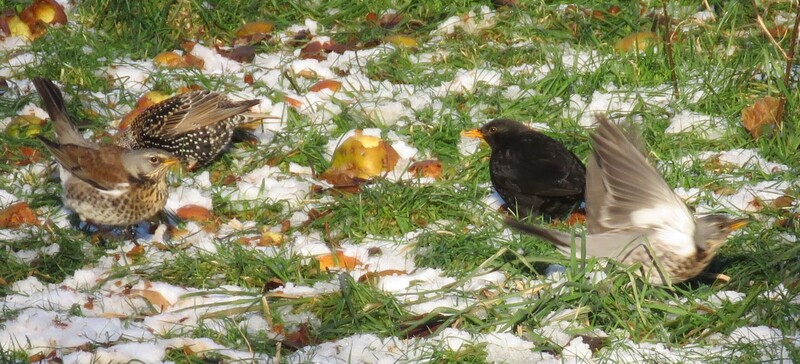 December orchard
December orchard The low winter sun casts a raking light and long shadows. A hedge and trees thick with ivy give shelter and a roost when darkness falls, and night comes early on a winter's day. Yesterday the temperature never rose above zero. Today it's 1 degree and bitterly cold out of the sun. Our shadows peep above the stone wall as we peer amongst orchard trees leafless and bare of fruit. Rosy windfalls lie in a sprinkling of snow and birds feast on them. What are all those birds amongst the fallen apples?
Next day temperatures hovered around freezing, rose to 2 degrees just before sundown- although the sun did not appear. There was sleet and a thin, watery snow. I thought upon the birds we had watched feeding on orchard windfalls. As we all struggle to keep cosy indoors picture those vulnerable creatures roosting in a hedge through a long winter's night.
The Woodland Trust tells that the name Fieldfare comes from Anglo-Saxon Feldware, traveller of the fields. Whilst writing About Scout Scar I was reading Thomas Bewick's History of British Birds 1797. His wood engravings are exquisite in closely observed detail and an evocation of habitat. His was close observation in the field, then drawing from skins- natura morta, still life. His engravings cannot show the animation glimpsed in a still photograph, or realised in video. His starling and bullfinch are detailed studies in black and white. He catches neither the iridescence of starling plumage nor the warm colour of bullfinch. If only we in our time might experience the abundance an 18th century naturalist would have known, the everyday vitality of huge flocks of fieldfare and murmurations of innumerable starling. We have all the opportunity of 21st century binoculars and cameras but loss of species and of a dramatic fall in numbers means we have to search for sightings that would have been daily fare for Thomas Bewick.

















 RSS Feed
RSS Feed